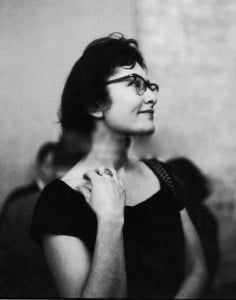 I thought I knew Denise Levertov.
I thought I knew Denise Levertov.
In the 1970s, she and my husband were both part of the English department faculty at Tufts University. He was writing about the Beat poets, whom Denise had known well, and she graciously came to our house for my husband to interview.
I used to walk by her house, in our neighborhood, and admire the brilliant flowers in her English garden.
Yes, I thought I knew Denise Levertov. I’ve read most of her poetry many times. After 9/11, I read it through once again, in order, starting with her 1961 collection, The Jacob’s Ladder.
I needed to be with Levertov’s poems daily because I knew that she’d engaged the difficult political issues of her day: the Vietnam War, the nuclear arms race, U.S. interventions in Latin America. I thirsted for her poetic insights on how to engage the post-9/11 world.
But now I realize I scarcely knew Levertov at all until reading this first complete biography of her, Dana Greene’s Denise Levertov: A Poet’s Life.
Levertov died in 1997, and it has taken fifteen years for us to get this sensitive, probing look at her entire life. But now we have it—and what a treasure it is.
Grounded in the soundest scholarship, drawing from Denise’s diaries and letters, interviews with people who knew her, as well as her published works, Greene’s narrative is thoroughly engaging and illuminating.
I’d known a bit about Levertov’s heritage, that she was born in England, her mother Welsh, her father a Hasidic Jew from Russia who had converted to Christianity and became an Anglican priest. But of the tense texture of her family life, growing up in this home with her troubled older sister, I knew nothing until reading Greene’s account.
I’d known that Levertov married the American Mitch Goodman and came to the U.S. with him in 1948, that they had a son, and that eventually their marriage dissolved.
But of her abortion before she met Mitch, the difficulties in their marriage almost from the start, Denise’s frustration with motherhood, Mitch’s jealousy of her growing acclaim as a poet, her anxieties and moody insecurities—all this was new to me, laid out by Greene with forthrightness and tact.
I’d known that Levertov was fairly quickly acclaimed as a poet in the U.S. But I hadn’t thought at all about an important point Greene makes:
In the 1950s, well before the women’s movement, women were expected to be housewives and nothing more. Levertov chafed under this stricture (as did many creative women at the time). She hated domesticity but was offered no alternative by the culture. As a female poet, she was looked upon as something of an oddity.
I’d known, from some of Levertov’s poems about her activism during the Vietnam War, that the war and her engagement in the protest movement caused her great inner pain and turmoil. But I hadn’t a clue about how tumultuous Levertov’s friendships and psychic life were all through her early adulthood and into her fifties.
Greene is thorough and masterful in tracing this dimension of her subject. Having read all of Denise’s diaries and the letters available in archives, Greene shows us a woman who was, in Greene’s words “a difficult friend.”
Denise could be impulsive and even cruel to her friends; she always said exactly what she thought, even if it would hurt others. She had a deep need to be adored and—as she reached middle age—to feel young. This need, along with strong sexual desires, compelled her into affair after affair, mostly with men considerably younger than she.
I found it hard learning about Levertov’s emotional instability and psychic needs. Greene handles them with sensitivity and non-judgmental honesty. But, still, learning about the inner pain of another is always sad.
A wise friend of mine said recently that everyone’s story includes suffering. Yes, but hearing the story, always unique in its anguished details, is difficult.
What a relief and a joy, then, to come, with Greene, to the happier story of Levertov’s religious conversion. From Levertov’s published essays and poems about her spiritual journey, I’d known the outline:
Her poetry had always celebrated mystery, even while she considered herself an agnostic. At age fifty-eight, while writing the long poem “Mass for the Day of St. Thomas Didymus,” she experienced her first sense of the “unknown” as a God who became helpless for our sake. Eventually she was led, at age sixty-seven, to communion in the Catholic Church.
But, oh, the rich details of this long conversion process that Greene adds from the diaries!
While writing the Didymus poem, Denise notices herself “hesitantly turning” toward Christian faith. As Greene felicitously puts it: “her lifelong experience of wonder and awe was being reconfigured.”
As Levertov’s embrace of faith deepens during the early 1980s, new terms enter her diary: grace and gratitude. The neediness and psychic tensions that had plagued her earlier life gradually dissolve into a grateful calm.
She starts pondering life’s sacramentality… and begins slipping into churches for worship services. She confides to her diary: “What is sought is the experience of the love of God… to really believe that God loves you—to feel it.”
As Levertov’s spirituality matured toward the end of her life, she reflected in her diary “that faith requires imagination; not in order to deceive ourselves into believing what is not true but precisely in order to grasp what is true but is too amazing in its uniqueness to be easily believed.”
Levertov always insisted that, as Greene says, “her poems emerged from her life experience.”
Tomorrow’s post will take up Greene’s account of the poetry that emerged from this life.











